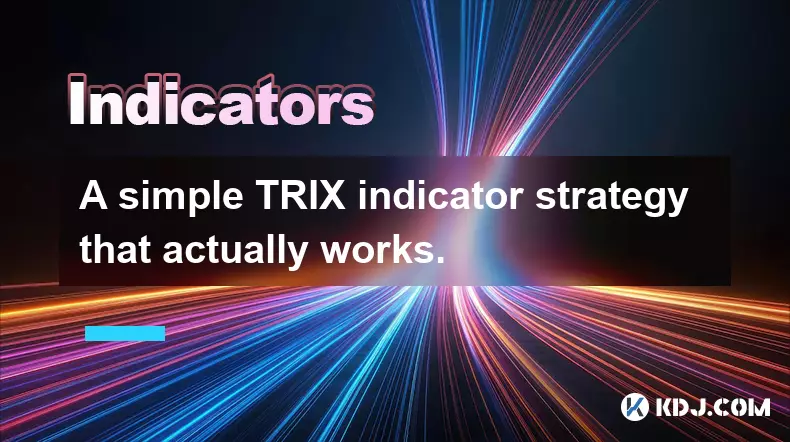-
 bitcoin
bitcoin $101752.865364 USD
-1.09% -
 ethereum
ethereum $3382.985899 USD
-1.38% -
 tether
tether $0.999658 USD
0.04% -
 xrp
xrp $2.272505 USD
-1.51% -
 bnb
bnb $989.089004 USD
0.14% -
 solana
solana $156.962612 USD
-3.08% -
 usd-coin
usd-coin $0.999776 USD
0.01% -
 tron
tron $0.290786 USD
-0.69% -
 dogecoin
dogecoin $0.174594 USD
-2.86% -
 cardano
cardano $0.560085 USD
-3.55% -
 hyperliquid
hyperliquid $40.023704 USD
-5.75% -
 chainlink
chainlink $15.324649 USD
-2.78% -
 bitcoin-cash
bitcoin-cash $493.576540 USD
-3.52% -
 zcash
zcash $571.320038 USD
-12.05% -
 stellar
stellar $0.280066 USD
-4.26%
How to combine KDJ with MACD for better trading signals?
Combining KDJ and MACD indicators enhances crypto trading accuracy by merging momentum and trend analysis, reducing false signals in volatile markets.
Oct 18, 2025 at 07:58 pm

Understanding KDJ and MACD Indicators in Crypto Trading
1. The KDJ indicator, also known as the Stochastic Oscillator, measures momentum by comparing a cryptocurrency's closing price to its price range over a specific period. It consists of three lines: %K, %D, and %J. Traders use it to identify overbought or oversold conditions, particularly useful in volatile markets like Bitcoin or Ethereum.
2. The MACD (Moving Average Convergence Divergence) tracks trend direction, strength, and momentum by calculating the difference between two exponential moving averages. A signal line and histogram accompany the main MACD line, helping traders spot potential reversals and continuations.
3. In the fast-moving crypto market, relying on a single indicator can lead to false signals. Combining KDJ with MACD enhances accuracy by merging momentum analysis with trend-following capabilities, reducing noise during sideways or choppy price action.
4. When both indicators align—such as showing bullish crossovers simultaneously—the probability of a valid trade setup increases significantly. This dual-confirmation method is widely adopted among algorithmic trading bots and professional traders within the blockchain asset space.
5. Many digital asset exchanges, including Binance and Bybit, offer built-in charting tools that allow seamless integration of both KDJ and MACD, enabling real-time monitoring across various timeframes from 5-minute candles to daily charts.
Key Signal Combinations for Entry and Exit Points
1. A buy signal emerges when the KDJ’s %K line crosses above the %D line in the oversold zone (below 20), while the MACD histogram begins expanding after a trough, indicating strengthening upward momentum. This combination often precedes sharp rallies in altcoins like Solana or Avalanche.
2. Conversely, a sell or short entry is considered strong when %K crosses below %D in the overbought region (above 80), coinciding with MACD bearish crossover—where the MACD line drops below the signal line—and the histogram turning negative.
3. Divergence plays a critical role. If the price makes a higher high but the KDJ fails to surpass its previous peak, and the MACD shows decreasing positive momentum, this bearish divergence warns of an impending correction, common before major BTC pullbacks.
4. In ranging markets, traders watch for KDJ reversals near support and resistance levels while confirming with flat or neutral MACD readings. This prevents entering trades based on false breakouts generated by one indicator alone.
5. During strong trending phases, such as bull runs fueled by ETF approvals or halving events, MACD trends dominate. KDJ can be used to identify temporary pullbacks for re-entry rather than reversal signals, avoiding premature exits.
Practical Application Across Timeframes and Assets
1. On shorter timeframes like 15-minute or 1-hour charts, scalpers combine KDJ and MACD to capture quick swings in meme coins such as Dogecoin or Shiba Inu, where volatility spikes are frequent and unpredictable without confirmation filters.
2. For swing traders holding positions over days, weekly KDJ/MACD alignment on the daily chart provides high-probability setups. For instance, a bullish crossover in both indicators after a prolonged consolidation often precedes breakout moves in Layer 1 tokens.
3. Institutional-grade strategies deployed by crypto hedge funds frequently incorporate these indicators into multi-layered models that include volume profiling and on-chain data, ensuring robustness against manipulation in low-liquidity markets.
4. Stablecoins and wrapped assets, though less volatile, still exhibit detectable patterns. Monitoring KDJ extremes alongside MACD shifts helps manage arbitrage positions across decentralized exchanges like Uniswap or Curve Finance.
5. Backtesting historical candle data using platforms like TradingView allows traders to validate how well KDJ-MACD combinations performed during past market cycles, including black swan events like the 2022 FTX collapse or the 2020 Bitcoin crash.
Frequently Asked Questions
What settings work best for KDJ and MACD in crypto trading?Common configurations include a 9-period KDJ with smoothing factors of 3, and MACD set at (12,26,9). However, due to heightened crypto volatility, some traders adjust KDJ to 5 or 7 periods for faster response, especially on lower timeframes.
Can KDJ and MACD be used during news-driven market events?Yes, but caution is required. High-impact news such as regulatory announcements or exchange outages may cause both indicators to generate delayed or conflicting signals. It's advisable to widen timeframes or pause automated strategies during such moments.
Do DeFi tokens respond differently to KDJ-MACD signals compared to large caps?DeFi tokens tend to have sharper swings and more frequent overbought/oversold readings due to lower liquidity. While the same logic applies, traders often require tighter stop-losses and secondary confirmation from volume or funding rates when applying these indicators.
Is it safe to automate trading using KDJ and MACD crossovers?Automated bots can execute KDJ-MACD strategies effectively, yet they must include risk controls. Sudden flash crashes or pump-and-dump schemes common in small-cap cryptos can trigger whipsaws, leading to significant drawdowns without proper safeguards.
Disclaimer:info@kdj.com
The information provided is not trading advice. kdj.com does not assume any responsibility for any investments made based on the information provided in this article. Cryptocurrencies are highly volatile and it is highly recommended that you invest with caution after thorough research!
If you believe that the content used on this website infringes your copyright, please contact us immediately (info@kdj.com) and we will delete it promptly.
- Ripple (XRP) in 2026: Hold or Fold? A Look at XRP's Future and Emerging DeFi Alternatives
- 2025-11-08 18:35:01
- Zcash ZEC Coin Price Explosion: From Privacy Niche to Center Stage
- 2025-11-08 18:55:01
- Berachain Price Prediction: Navigating the Honeycomb Hype in Crypto
- 2025-11-08 18:55:01
- Arthur Hayes, Gold, and Bitcoin: A Modern Monetary Trinity?
- 2025-11-08 19:15:01
- Shiba Inu's Next Move: Navigating a Shifting Market
- 2025-11-08 19:20:01
- Pakistan's Crypto Crossroads: Balancing Opportunity with Asset-Backed Realities
- 2025-11-08 19:20:01
Related knowledge

How do professional traders use the TRIX indicator?
Nov 06,2025 at 04:40pm
Understanding the TRIX Indicator in Crypto TradingThe TRIX (Triple Exponential Average) indicator is a momentum oscillator used by professional trader...

Can I use the TRIX indicator on my mobile trading app?
Nov 07,2025 at 07:40pm
The TRIX indicator, a momentum oscillator designed to filter out short-term fluctuations and highlight long-term trends, has become increasingly popul...

How to code a simple TRIX indicator script in Pine Script?
Nov 07,2025 at 06:20am
How to Code a Simple TRIX Indicator in Pine Script The TRIX (Triple Exponential Moving Average) indicator is widely used in cryptocurrency trading to ...

A simple TRIX indicator strategy that actually works.
Nov 08,2025 at 05:39pm
Understanding the TRIX Indicator in Crypto Trading1. The TRIX (Triple Exponential Average) indicator is a momentum oscillator designed to filter out s...

How to trade TRIX indicator signals on the 1-hour chart?
Nov 07,2025 at 05:39am
Bitcoin's Role in Decentralized Finance1. Bitcoin remains the cornerstone of decentralized finance, serving as a benchmark for value and security acro...

Can the TRIX indicator be used for long-term investing?
Nov 06,2025 at 02:19pm
Understanding the TRIX Indicator in Cryptocurrency Markets1. The TRIX (Triple Exponential Average) indicator is a momentum oscillator designed to filt...

How do professional traders use the TRIX indicator?
Nov 06,2025 at 04:40pm
Understanding the TRIX Indicator in Crypto TradingThe TRIX (Triple Exponential Average) indicator is a momentum oscillator used by professional trader...

Can I use the TRIX indicator on my mobile trading app?
Nov 07,2025 at 07:40pm
The TRIX indicator, a momentum oscillator designed to filter out short-term fluctuations and highlight long-term trends, has become increasingly popul...

How to code a simple TRIX indicator script in Pine Script?
Nov 07,2025 at 06:20am
How to Code a Simple TRIX Indicator in Pine Script The TRIX (Triple Exponential Moving Average) indicator is widely used in cryptocurrency trading to ...

A simple TRIX indicator strategy that actually works.
Nov 08,2025 at 05:39pm
Understanding the TRIX Indicator in Crypto Trading1. The TRIX (Triple Exponential Average) indicator is a momentum oscillator designed to filter out s...

How to trade TRIX indicator signals on the 1-hour chart?
Nov 07,2025 at 05:39am
Bitcoin's Role in Decentralized Finance1. Bitcoin remains the cornerstone of decentralized finance, serving as a benchmark for value and security acro...

Can the TRIX indicator be used for long-term investing?
Nov 06,2025 at 02:19pm
Understanding the TRIX Indicator in Cryptocurrency Markets1. The TRIX (Triple Exponential Average) indicator is a momentum oscillator designed to filt...
See all articles





















![The Graph Price Prediction [GRT Crypto Price News Today] The Graph Price Prediction [GRT Crypto Price News Today]](/uploads/2025/11/07/cryptocurrencies-news/videos/690d4df44fe69_image_500_375.webp)




















































